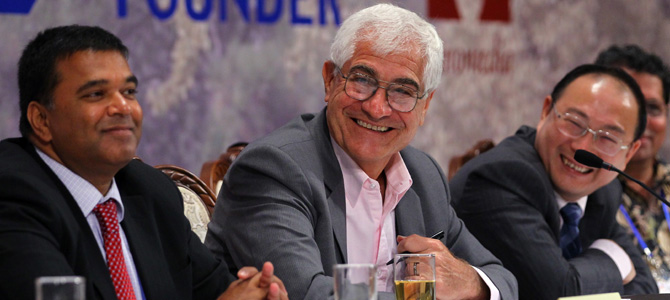
III. Effectively Protecting and Rationally Utilizing Rare Earth Resources
Rare earths, as a non-renewable natural resource, need to be effectively protected and rationally utilized. As part of its drive to ensure the sustainable use of resources, China has been practicing protective exploitation of its rare earth resources for many years.
According to China's Mineral Resources Law promulgated in the 1980s, the state adopts a policy of planned exploitation with regard to mining areas that are embraced in state plans and are of great value to the national economy and specified minerals for which protective exploitation is prescribed by the state. In 1991, China prescribed protective exploitation for ion-absorption rare earth resources, exercising planned, unified control in all related procedures, including mining, dressing, smelting, processing, selling and export. In 2006, China began to exercise total-amount control over the exploitation of rare earths. In 2007, the state incorporated the production of rare earths into management by mandatory planning. In 2008, the state issued the National Plan for Mineral Resources (2008-2015) to exercise planned regulation and control, restrictive exploitation, tightened access and comprehensive utilization for rare earths and some other specified mineral resources, of which protective exploitation is prescribed by the state. In 2009, the state took back the power for registering, examining and approving the prospecting and mining of specified minerals, of which protective exploitation is prescribed by the state. In 2011, China adjusted the tax rates on mining of rare earths. The adjusted new tax rate for light rare earths (including bastnaesite and monazite) is 60 yuan per tonne, and for middle and heavy rare earths (including xenotime and ion-absorption rare earths) is 30 yuan per tonne, much higher than the rates before the adjustment, which ranged from 0.4 yuan per tonne to 2 yuan per tonne. The state also established a strategic reserve system and kept the rare earth reserves in the form of resources and products, designated the first 11 rare earth mining areas to be embraced in state plans, and formulated a special plan for key rare earth mining areas. China has tightened control on mining rights and enforced a system of mining rights allocation plans. In principle, the state has put a moratorium on accepting new registration applications for rare earth prospecting and mining, and prohibits existing mines from expanding their production capacities. The state exercises strict control over the total rare earth mining and production volumes to reduce resources development intensity, slow the depletion of resources, and advance sustainable development.
In recent years, China has launched special campaigns to regulate rare earth mining and production, effectively protecting and rationally utilizing rare earth resources in various ways. The state has tightened control of the total volume of rare earth mining and mandatorily planned quotas for rare earth production by means of satellite photography, video monitoring, regular inspection, monthly report system, special invoice checking, and opening phone lines to receive reports concerning violations of related laws and regulations. In pursuance of related laws concerning rare earths, China has cracked down on illegal rare earth mining and mining that exceeded quotas prescribed by the state, as well as on production activities of rare earth smelting and separation enterprises that were unplanned or exceeded the state-set quotas. China also has strengthened joint supervision in key rare earth production areas, investigated and punished rare earth enterprises that conducted mining and production in violation of laws and regulations, polluted the environment, caused wastes in resources, or did not have the necessary conditions to ensure production safety, and called to account those enterprises and individuals responsible for these violations in accordance with the law. The state has re-examined permits for rare earth prospecting and mining, and publicized a list of legitimate mining enterprises. It has also accelerated the formation of a long-term mechanism for regulating the market order and supervision of rare earth mining and production, advancing the merger and reorganization of rare earth enterprises, and phasing out outdated processes and capacities to realize large-scale and intensive production. By way of special rectification campaigns, more than 600 cases of illegal prospecting and mining were investigated and rectified, more than 100 cases were placed on file for further action, and 13 mines and 76 smelting and separation enterprises were ordered to cease production for rectification. In this way, the trend of illegal mining and production has been reversed.
The Chinese government has stressed the comprehensive utilization of rare earth resources. Over the past few years, the state has reinforced research into the geological structure of ion-absorption rare earth mines, advanced the building of "green" mines and comprehensive utilization demonstration bases, developed environmental-friendly and efficient mining technologies to increase the recovery rates of rare earths by a large margin, extended support to the development of new flotation reagents and ore-dressing equipment to raise the dressing recovery rates of rare earths, and worked to recover lean ores and tailings. China promotes balanced utilization of rare earth elements, encourages research into the application of light rare earth elements, such as lanthanum and cerium, whose reserves are relatively abundant, and expedites the development of technology for reducing or providing substitutes for the use of scarce heavy rare earth elements, such as europium, terbium and dysprosium. The state also fosters the comprehensive recycling of paragenetic ores of scarce rare earths that are difficult to recover during the process of ore dressing and smelting, and encourages the recycling of rare earth associated ores, including niobium, tantalum, thorium, strontium, potassium and fluorite.
China gives great support to the development of the circular economy in this field, and works hard for the recovery and utilization of secondary rare earth resources. The state encourages the development of special processes, technologies and equipment for the collection, processing, separation and refining of rare earth wastes, supports the building of specialized bases for the recovery and utilization of secondary rare earth resources, including molten salts after pyrometallurgy, slag, waste permanent magnet materials and motors, waste NiMH batteries, waste fluorescent lamps, dead catalysts, used polishing powder, and other waste electronic components containing rare earth elements.


 Washington to remain focused on Asia-Pacific
Washington to remain focused on Asia-Pacific RQFII target blue chips amid bear market
RQFII target blue chips amid bear market Australian recall for top two exporters
Australian recall for top two exporters China fears new car restrictions
China fears new car restrictions